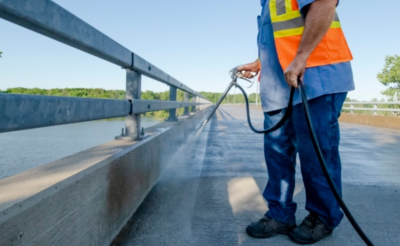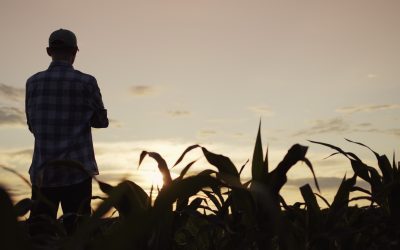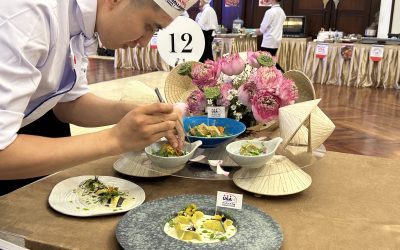Young farmer has his eye on diversifying future assets
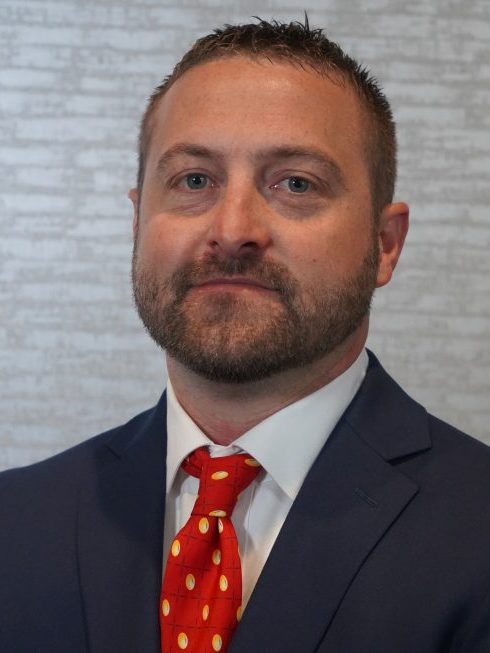
BY ANN HINCH
Closing out his column in last fall’s Indiana Corn & Soybean Post, then-ISA Membership & Policy Committee Chair Matthew Chapman wrote: “Remember that without big dreams, there are no big accomplishments.”
Accomplishing his own big dreams means that within 20 years he would ideally “be
diversified in 20 different businesses,” farm related and not. It does seem possible that Chapman, 39, could achieve this empire given his job creation pace, so far.
At 15, he and younger brother, Jacob, started a baling business to sell hay to the horse track in nearby Anderson. They ran two crews each summer, and Chapman used his share of income to help pay for a degree from Purdue University.
Upon the birth of his first child, Grace – now 8 – he realized he wanted to replace those working weekends with time for his family, so the brothers sold the business. Chapman plowed his portion back into a trucking business, which fits his schedule better and complements the farm operation he and Jacob were taking over from their parents, Tim and Brenda.
“Trucks can work in the rain – and you can’t bale hay in the rain,” he pointed out. He now employs seven full-time drivers and is assisted behind the scenes by his wife, Brianna, also an entrepreneur who recently sold her florist businesses.
Chapman also owns rental homes and is a partner in rental storage units. Most notably he and Jacob have co-owned and run the second-generation Chapman Brothers family farm for the last decade, where they grow corn, soybeans and wheat and raise pigs under contract for Country View Family Farms.
They sell the soybeans to a local processor that turns them into oil and meal for pigs, and their corn splits about half-and-half between local ethanol production and to an elevator with a rail spur shipping feed to the Southeast for poultry flocks.
The first generation
“Dad always had in his head that we would come back to the farm to run it,” Chapman said, describing how Tim built his own farm over a few decades.
Raised by a third-generation farmer in Henry County, Tim Chapman followed his father’s advice to do something different – earn an accounting degree and go to work for the USDA. In the wake of the farm crisis and foreclosures in the 1980s, Tim’s dad gave him additional advice: If he was still interested in farming, rent available acreage and go in on shares of equipment and supplies with other growers.
As older farmers passed on, Tim purchased parcels of land and grew his own operation. He had an advantage over many other farmers in that he understood USDA programs from the inside and knew how to apply their requirements to his farm.
Matthew Chapman mused that if his father had begun farming out of school, he likely would have suffered in the 1980s agricultural recession, as well.
In transitioning the farm to him and Jacob in 2014, Chapman said it took not only a lot of planning but grace and patience on their father’s part to take a pay cut “and bite his tongue” to not micro-manage when the brothers imposed their own management style. Chapman refers to this as him “letting us do dangerous things carefully.
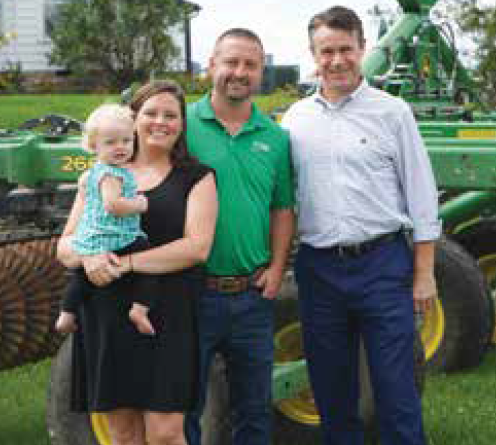
summer of 2022 for a Shop Talk hosted by the Indiana Soybean
Alliance Membership & Policy Committee and the Indiana Corn
Growers Association.
“I learn from making mistakes; sometimes, expensive ones,” he admitted.
One change the brothers have made is putting more effort into soybean preparation. He noted there has been a habit of careful prep work for corn planting compared to a more laidback attitude toward soybeans, which are seen as less profitable and more hardy. The market has changed, though, and there are now more premiums for beans. This year, for instance, the Chapmans are expanding their production of high-oleic soybeans.
Another effort he tried in 2021 wasn’t as successful. He seeded one winter wheat field with every other row missing and at soybean planting time, put beans into those empty rows. Chapman said he was copying another farmer successfully incorporating the planting with his manure application, the idea being that the taller wheat shields young soy plants from weather – and when wheat is harvested, the introduction of sunlight feeds bean photosynthesis at a crucial stage. Too, the remaining chaff helps soil hold water and reduces weed pressure.
The goal is to sacrifice some wheat yield for more beans than one gets in a bean-only field and protect soil health. At the time, Chapman realized his was an imperfect experiment because he did not have the specialized equipment the original grower had modified for himself.
“I kind of tried to cheat with some of the stuff I already had,” he said. “Didn’t work as good as I liked.”
Neither crop was spectacular since he found it impossible to harvest the wheat fully without cutting off the tops of bean plants with his standard equipment. He knows what he did wrong and might try again someday. Done well, this may be one method to ease other indecisive growers into using cover crops. For one, winter wheat is a familiar crop that has harvest value; second, if the crop “is a disaster” or has to be sacrificed to preserve the soybeans, a farmer is not out a great deal of money, still gets the benefit of wheat as cover and it’s an easier crop to burndown than, say, annual ryegrass.

Board life
In the early 2010s, newlyweds Matthew and Brianna became involved with Young Farmers of the Indiana Farm Bureau Federation. Appointed to represent their district by then-IFBF president Don Villwock, Chapman said, “That was an awesome experience and got us our first taste at serving on a larger board, and kind of whetted my appetite for the (ISA) because a lot of my same team members from that committee are on the soybean board or have been in the past.”
They were candidates for the annual Young Farmers Achievement award a few years before finally winning in 2017.
He was first elected to the ISA board in 2013 as its youngest director at the time (going on to serve nine maximum years, including as its chairman 2021-22). He has since served in other groups, including on the board for the Henry County Soil and Water Conservation District (SWCD), holding a state-appointed seat on the USA Poultry and Egg Export Council and (briefly) on the U.S. Meat Export Federation – and in late 2022, appointed to the United Soybean Board by the USDA.
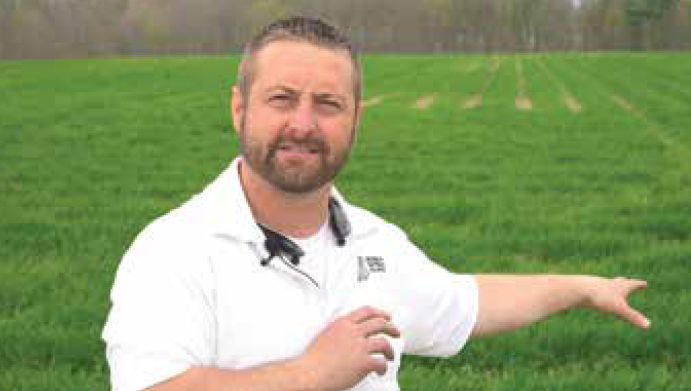
he often shares his results with other farmers.
He ran for the ISA to see how his checkoff money was being spent and, in his words, to diversify his pool of resource people. “I tell the new guys that this is an unpaid board,” Chapman said. “They pay us in food and desserts at the meetings. But if you’re not finding a way to make money off this board” through networking and learning from more experienced farmers – “then you’re doing it wrong.
“I gained so much; I receive more than I give, for sure. I wish everybody felt that way and participated that way.”
One boon of his time on the ISA and national boards has been trade missions to other countries. “When I travel, I like to travel with a purpose, to either learn something about my competitors or learn something about how the rest of the world handles problems or how they face them,” he explained.
He has visited Costa Rica, China, Vietnam, Singapore, Dubai, Malaysia, Colombia, Morocco and, just this spring, Argentina. While it’s one thing to read trade news, it’s another level to travel somewhere. Learning more on-site about religious customs that forbid pork consumption, for instance, helped him better understand the opportunity for poultry and eggs in those markets. Traveling with brokers, distributors and restauranteurs trained him how to look for specific customer needs and marketing practices.
Sometimes the lesson is logistics. At a warehouse with local officials in Dubai, Chapman saw how Polish distributors filled their shipping containers, compared to space left over in U.S. containers as a result of weight restrictions imposed at U.S. ports. The result was that Polish shippers could sell at a lower per-unit cost and with less breakage. Learning such as this aids groups like the Soy Transportation Coalition to work on lobbying for regulation changes to give U.S. farmers advantages overseas.
“It’s just something your average everyday farmer doesn’t see or think about,” he noted – including him at one time.
And while he is mindful of competition when it comes to business, Chapman likes to see other farmers succeed and to help where possible. He and others on the SWCD back home, for instance, have tried to aid those in Henry County to find and apply for cost-sharing and other incentives to transition into conservation practices like cover-cropping.
Being able to market their operations and products as “climate-smart” or “carbon-sequestering” will be savvy for farmers at some point, he noted, and many would prefer to do this at a slower pace voluntarily than be forced quickly at some point via regulation. One of the best ways to make such methods attractive to a busy farmer is to help them find a way to implement at a low cost and gradually.
The road ahead
In addition to Grace, he and Brianna have June, 5, and Maeva, almost 2 years old. Harvest is his favorite time of the year because it’s a more relaxed pace and their daughters can be more involved. June is an animal lover, and her
older sister has pigs in 4-H (“But I don’t know that that’s her favorite thing,” Chapman observed).
“My goal is that I have been successful
enough that whatever job or career or
dream they choose, we have the ability
to make that happen nearby. ’’
“Every chance I get, I hide the (TV) remote from them,” he said. “I want them outside all the time.” If any want to go into agriculture, that’s wonderful – but he is more concerned with enabling each to have a choice of career.
And, in keeping them as close as they’re willing to live when they grow up. “My goal is that I have been successful enough that whatever job or career or dream they choose, we have the ability to make that happen nearby.”
He admits being away from the farm for a while was good. His father convinced him to go to college “and come back when I was mature and ready to work.” He didn’t want to go – but now is glad he did, not just for the lifelong friends he met, including his wife, but that it gave him the chance to see how well Dad could run the farm without his help. He explained this was humbling and shifted his thinking about what he could bring to the family operation as an adult.
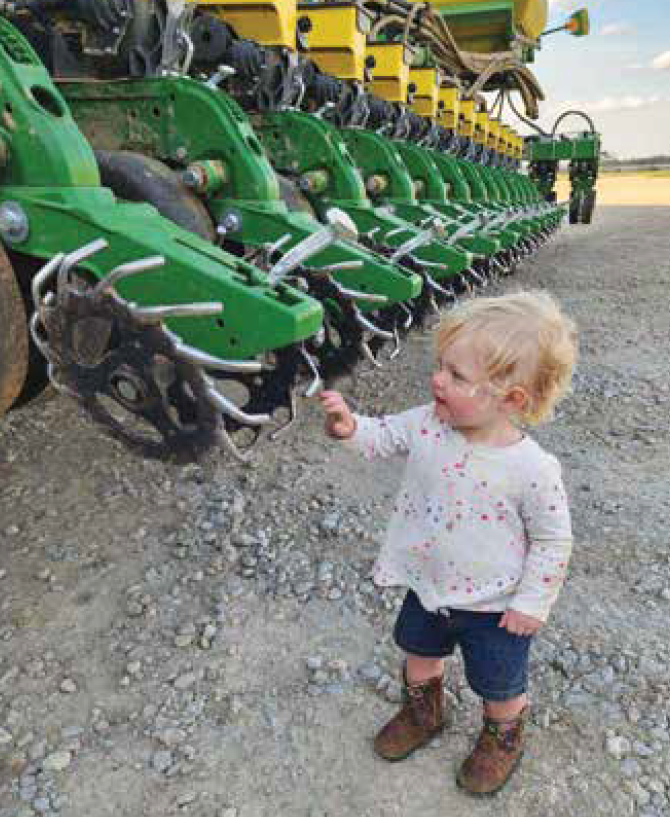
One dream Chapman has for diversifying into those future multiple business interests is building a local complex for medical imaging or dentistry (or perhaps one of each). For example, a dental complex could contain separate offices for different specialties and all ages of patients and employ multiple dentists who share staff and insurance billing resources. This would help young dentists without capital establish their own practices and be a way for one business to “keep a customer for life, hopefully.”
And medicine seems to be a recession-proof industry, which is attractive. “In today’s world we compete a lot with outside investors … and I’m determined I’m going to be my own investor,” he added.
Compared to farming, his experience in non-ag businesses has been easier. “When you can control so many moving parts, the risk is a lot less,” he said, ticking off some things a farmer cannot dictate: weather, market prices, energy and other input costs, rent. Whereas, “if I’m not paid the rate I want for my trucks, they sit in the driveway.”
If he wasn’t farming, whatever he had chosen, “I would have to be the boss, unfortunately,” Chapman quipped. “I have too much of my dad in me to work for somebody else.”
Posted: May 3, 2023
Category: Indiana Corn and Soybean Post - Spring 2023, ISA, News

